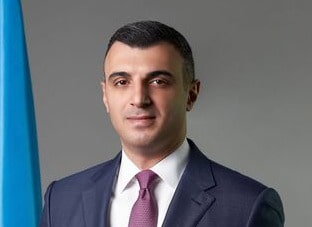Taleh Kazimov, governor of the central bank of Azerbaijan discusses central banking, monetary policy amid rising energy prices, and more with Global Finance.

Global Finance: Do Azerbaijan’s solid energetical matrix and strategic geopolitical positioning hold the key to a better-than-average overall economic performance in the years ahead?
Taleh Kazimov: The answer to the question lies in understanding how the economy has grown over the years. Azerbaijan had a remarkable run of growth over the last two decades. Economic growth tripled thanks to dynamic development and market-oriented reforms. During this time, the economy has successfully shown a high level of resistance to various external shocks. Despite these unprecedented shocks, Azerbaijan’s economy successfully remained on the growth path of diversifying its non-oil economy, especially non-oil exports.
Under the great leadership of His Excellency Ilham Aliyev, Azerbaijan has a great vision for achieving sustainable and high economic growth in the future. There is a well-developed socioeconomic strategic plan for the economy of the country—the 2022-2026 State Strategy—which was adopted this year. In a nutshell, this strategy is designed to engineer sustainable economic growth, enhance the resilience of the economy, encourage the inclusiveness of society, create high competencies and skills demanded in the 21st century and ensure the development of a green economy.
GF: How have recent geopolitical events influenced Azerbaijan’s monetary agenda?
Kazimov: Azerbaijan, like many other countries in the world, faced high inflation shocks since mid-2021. It is important to say that the nature of the inflation pressures was quite different this time. Since my first days as the chairman of the Central Bank of Azerbaijan at the beginning of 2022, fighting against double-digit annual inflation was a key part of my policy agenda. Our first step was to assess the efficiency of monetary policy. Then, we undertook key reforms to improve the linkages between relevant channels of monetary transmission.
Our actions aimed to create the necessary infrastructure for the interbank money market, encouraging banks to actively participate in interbank money market operations. We introduced standing facility instruments, increased the number and frequency of open market operations and introduced various money market indices for benchmarking. We also started to tighten our monetary policy stance. The ratios for the required reserve were raised and differentiated by the liability size of banks. We carried out bill auctions regularly across four different maturities, which also supported the formation of the yield curve for national currency. These operations have led to the sterilization of the money base by $2 billion dollars since the beginning of 2022.
GF: Azerbaijan’s inflation has been particularly impacted by the core part of the reading. How do you counter that trend, in an economy that gains from rising energy prices?
Kazimov: As mentioned, the main concern for the central bank was high inflation; the fundamental question was the source of inflationary pressure. Our analysis showed that prices in the domestic market were elevated due to external supply factors. It is quite clear that the central bank will be less efficient in curbing externally driven inflationary pressure with monetary policy tools. During this time, Azerbaijan imported inflation from key trading partners, some of which have been significantly hit by high global food and energy prices. Our main strategy was to ensure that demand factors were under control by increasing the policy rate. Additionally, we maintained the stability of local currency in periods of excessive foreign currency supply. As a result, inflation was also reduced to some extent by the appreciation of the nominal effective exchange rate.
Oil revenue does not directly affect inflation through the aggregate demand channel. According to the institutional framework, the State Oil Fund (SOFAZ) receives all oil and gas revenue and transfers the predefined amount of that revenue to the state budget in accordance with the fiscal rule.
GF: Other than raising interest rates, Azerbaijan has been conducting several currency auctions. How does the central bank assess the impact of this two-pronged approach to fighting inflation?
Kazimov: This issue has two dimensions. Interest rate and exchange rate channels complement each other in Azerbaijan, requiring significant coordination between fiscal and monetary policies. The central bank rarely intervenes in the foreign currency market. As mentioned above, the State Oil Fund supplies the state budget with manat by converting its foreign currency into the market. We just organize these auctions between the fund and commercial banks. These actions do not influence the foreign currency reserves of the central bank. We primarily conduct the monetary policy through an interest rate channel to affect aggregate demand. The exchange rate effect on reducing prices could be achieved only through appreciation of the nominal effective exchange rate.
GF: Developing Azerbaijan’s interbank market has been a primary focus for you. What are the main challenges and goals on that front right now?
Kazimov: One of the key priorities on the reform agenda has been the development of an interbank money market. We focus on three key dimensions: 1) the development of infrastructure, 2) encouraging the participants—banks—to be active in the market, and 3) the formulation of the benchmark short-term interest rates.
I think we have accomplished a lot in those areas. The volume of the interbank unsecured market, which was 787.5 million manats in September 2022, increased more than six times, reaching 4.9 billion manats in August 2023. This indicates that there is a great perspective in this segment of the interbank money market.
Moreover, the AZIR index, as a short-term benchmark interest rate, has been formed for the unsecured market. In parallel, the interbank secured market was also developed, and the AINA index was formed for this purpose. More information on monetary operations and those indices is available on the official website of the central bank. Our ultimate goal is to steer short-term interest rates within the monetary policy corridor and influence long-term interest rates.
GF: How does the Central Bank of Azerbaijan view the role of digital banking and fintech solutions in further enhancing accessibility and services?
Kazimov: We see that a growing number of central banks and regulatory authorities are increasingly interested in the digitalization of the financial sector. We also acknowledge the crucial role of fintech in modernizing the country’s financial system. The central bank recognizes that innovation is essential for transforming the banking sector and promoting financial inclusion.
The central bank particularly focused on advancing the digitalization of the financial system and facilitating the secure introduction of innovative financial services. To achieve these objectives, the central bank is currently developing a comprehensive fintech strategy. This strategy focuses on several key priorities: enhancing the competitiveness of financial services, improving efficiency and stability, nurturing the growth of a robust domestic fintech ecosystem and advancing professional training within the sector.
The recently adopted law on payment services and systems will support the development of fintech activity by encouraging a competitive environment for financial institutions. Additionally, the sandbox regime will provide testing opportunities for innovative and secure financial products.
GF: How have these efforts contributed to enhancing security and stability within the country’s banking sector?
Kazimov: We acknowledge that cyber resilience in financial markets is crucial. A cyberattack on any part of the financial markets has the potential to cause a systemic event leading to disruptions in the economy. In this regard, the central bank always keeps in focus issues related to improving cyber resilience and strengthening information security in financial markets.
These efforts contributed to developing a Cybersecurity Strategy in Financial Markets for 2023-2026, which is designed to be adaptable and to account for a continuously changing cyber landscape.
The strategy introduces five goals for strengthening cyber resilience in financial markets against evolving cyberthreats: 1) reinforcing the regulatory and oversight framework for information security and cybersecurity, 2) fostering the culture of cyber risk management in financial markets, 3) establishing an information technology management system, 4) strengthening cyber resilience in financial markets, and 5) forming a culture of information security and cybersecurity in financial markets.



